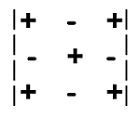Determinants in Discrete mathematicsDeterminants can be described as the scalar quantities which will be obtained when we add the products of elements of a square matrix and their cofactors on the basis of a prescribed rule. With the help of determinant, we will be able to determine the adjoint, inverse of the matrix, and many more. In case of the determinant, horizontal lines are used to indicate the rows, and vertical lines are used to indicate the columns. If there is a determinant with n order, in this case, it will have n rows and m columns. For example: Suppose there are two matrices, which are described as follows: 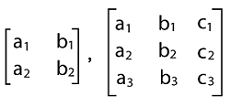
The determinant of this matrix is described as follows: 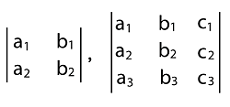
In this example, we have two determinants in which the first determinant contains the 2 order and the second determinant contains the 3 order. If there is a square matrix A with an order n*n, in this case, there must be a number associated with it which will be known as the determinant of a square matrix. For example: 1. If there is a matrix with an order of 1*1, then the determinant of it will be A = [a]. 2. Suppose there is a matrix with an order 2*2 
The determinant of this 2*2 matrix will be ad - bc. 3. Suppose there is a matrix with an order 3*3 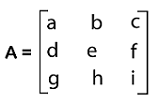
The determinant of this matrix will be a(ei − fh) − b (di − fg) + c (dh − eg). Note: If there is a determinant with an order n, then the number of elements will be n2.What are DeterminantsThe determinants can be described as a scaling factor of matrices. This matrix can be considered as a function that is used to shrink in and stretch out of the matrices. Just like the function, determinants take a square matrix in the form of input and return a single number in the form of its output. Definition of DeterminantsSuppose there is a square matrix, C = [cij] with an order n*n. The determinant of this matrix can be defined as a scalar value that is used to have a real or complex number. Here cij is used to indicate the (i, j)th element of matrix C. The determinant of matrix C will be indicated as |C| or det(C). We use the grid of numbers to write the determinants and arrange these numbers inside absolute value bars in place of using square brackets. For example: Suppose there is a matrix C where 
The determinant of this matrix can be written in the following way: 
How to calculate determinantIf there is a simple square matrix with an order 1*1, in this case, the matrix will have only one number, and the determinant of this matrix will be the number itself. Now we will see the matrix with 2-order, 3-order and 4-order, and how we can calculate the determinants of these matrices. Calculating determinant of 2*2 matrixThere is a determinant formula that can be used to determine the determinant of any 2D square matrix or any square matrix which contains the 2*2 order. For this, we will assume a square matrix with 2*2 order: 
In the following way, we can calculate the determinant of 2*2 matrix or 2D determinant: 
|C| = (a*d - b*c) For example: 
Now we will calculate its determinant in the following way: 
|C| = (8*4) - (6*3) |C| = 32 - 18 |C| = 14 Calculating determinant of 3*3 matrixWe have a determinant formula that will be useful to calculate the determinant of a 3*3 square matrix. Suppose there is a square matrix that contains the 3*3 order: 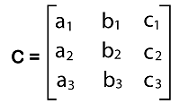
In the following way, we can show the determinant of this matrix: 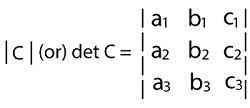
We can calculate the determinant of a 3*3 matrix with the help of some steps, which are described as follows:
Now we will understand it with the help of an example. Suppose we have a 3*3 matrix B where 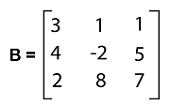
Now we will calculate the determinant of this matrix in the following way: 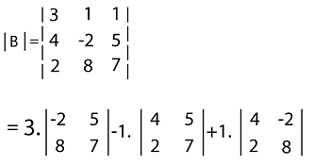
= 3 × ((-2)(7) - (5)(8)) -1 × ((4)(7) - (5)(2)) + 1 × ((4)(8) - (-2)(2)) = 3 × ((-14) - (40)) -1 × ((28) - (10)) + 1 × ((32) - (-4)) = 3 × (-54) -1 × (18) + 1 × (36) = - 162 - 18 + 36 = -144 In this example, we use the first row to find the determinant of a 3*3 matrix. But we can also use any row or column to determine the determinants of this matrix. Note: In conclusion, we can say that the formula to determine the determinant of a 3*3 matrix is described as follows: |C| = a1(b2c3 - b3c2) - b1(a2c3 - a3c2) + c1(a2b3 - a3b2)Calculating Determinant of 4*4 matrixSuppose there is a square matrix that contains the order 4*4 or a 4D square matrix. When we try to calculate the determinant of a 4*4 matrix, then there are some changes that we should keep in mind. The 4*4 matrix and the changes are described as follows: 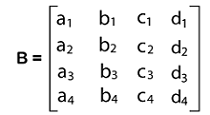
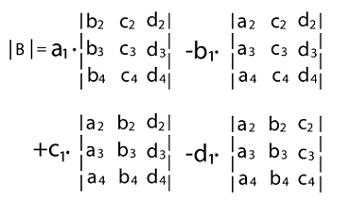
We can also use the method which we already learned in the above topic, i.e., "calculating determinant of 3*3 matrix" to find the determinant of 3*3 matrix. Here we will show a very easy way through which we can find the determinant of 3*3 matrix, which is described as follows: 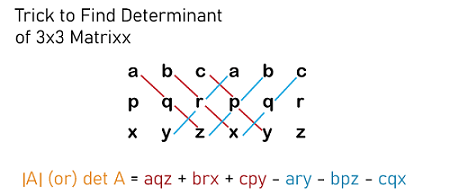
Multiplication of DeterminantsWe can multiply the two determinants of square matrices with the help of using a method which is known as multiplication of arrays. Now we will multiply two determinants of square matrices, A and B, of different orders with the help of row by column multiplication rule. Multiplication of 2*2 determinantsHere we will assume two square matrices, A and B, which contain the order 2*2. We can indicate the determinants of these matrices by the symbol |A| and |B|, respectively. The procedure to multiply these determinants is described as follows: 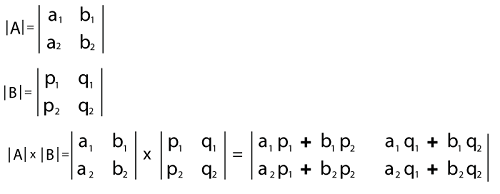
Multiplication of 3*3 determinantsHere we will assume two square matrices, C and D, which contain the order 3*3. We can indicate the determinants of these matrices by the symbol |C| and |D|, respectively. The procedure to multiply these determinants is described as follows: 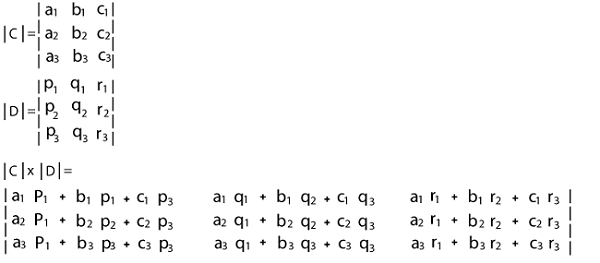
When we try to multiply two determinants, then there are some points that we should keep in mind. These points are described as follows:
Properties of DeterminantsSuppose there are some square matrices with different types. If we try to calculate its determinant, there are some important properties of determinants that should be followed to do this. We have listed the important properties of determinants, and some of them are described as follows: Property 1: "If there is an identity matrix, then its determinant will always be 1". Proof: For this, we will assume an identity matrix I where 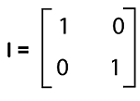
The determinant of this matrix is described as follows: |I| = (1)(1) - (0)(0) = 1 Hence, the determinant of any identity matrix will always be 1. Property 2: "If there is a square matrix B, which contains the order n*n, and if this matrix contain a 0 row and 0 column, then the determinant of this matrix will be 0, i.e., det(B) = 0". Proof: For this, we will assume the determinant of a square matrix B like this: 
|B| = (2)(0) - (2)(0) = 0. In the above square matrix B, we have one 0 row. Hence the determinant of matrix B will be 0. Property 3: "If there is a matrix C which is an upper or lower triangular matrix, then the determinant of this matrix will be the multiplication of all its diagonal entries". Proof: For this, we will assume an upper triangular matrix C, which contains 3, 2, and 4 as their diagonal entries. The determinant of matrix C is described as follows: 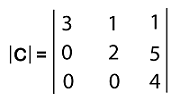
|C| = 3*2*4 = 24 Hence the determinant of C will be 24. Property 4: If there is a square matrix, and if the row of this matrix is multiplied by a constant k, in this case, the constant k will be taken out of the determinant. Proof:
In both matrices, we can see that the determinant remains the same. There are some other important properties of determinant, which is described as follows:
Rules for operations on DeterminantIf we try to perform the rows and columns operations, then there are some rules which will be useful. These rules are described as follows:
Important Notes on DeterminantsThere are some important points that we should keep in mind while learning the concept of determinants. These points are described as follows:
Examples of DeterminantsThere are a lot of examples of determinants, and some of them are described as follows: Example 1: In this example, we have a matrix A, and we have to determine the determinant of this matrix. The elements of this matrix are described as follows: 
Solution: The determinant of the above matrix can be written in the following way: 
Now we will determine the determinant of it by multiplying the diagonals and subtracting the products in the following way: |A| = (4*2) - (3*1) = 8 - 3 = 5 Answer: det(A) or |A| = 5 Example 2: In this example, we have a matrix C with 2*2 order, and we have to determine the determinant of this matrix. The elements of this matrix are described as follows: 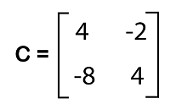
Solution: The determinant of the above 2*2 matrix can be written in the following way: 
Now we will determine the determinant of it in the following way: |C| = {(4)(4) - (8)(2)} = 16-16 = 0 Answer: The determinant of matrix C is = 0. Example 3: In this example, we have a matrix A with 3*3 order, and we have to determine the determinant of this matrix. The elements of this matrix are described as follows: 
Solution: Here, we will use the first row and expand the determinant of above 3*3 matrix. 
= 1 * (-1 - (-9) - 3 * (-3 - (-6) + 2 * (-9 - (-2)) = 1* (-1 + 9) - 3* (-3 + 6) + 2 * (-9 + 2) = 8 - 9 - 14 = -15 Answer: The determinant of matrix A is -15. Example 4: In this example, we have to determine the value of determinant with the help of properties of determinants. The determinant is described as follows: 
Solution: With the help of one of the properties of determinant, we will perform the elementary row transformation R1 → R1 + R2 + R3 on the above determinant. According to this property, the value of determinants will not be changed while doing the elementary row transformation. After performing the elementary row transformation (R1 → R1 + R2 + R3), the determinant will become the following: 
Now we will use one more property of determinant that says if the row or column of a matrix is 0, then the determinant of this matrix will also be 0. In the above matrix, the first row is 0. That's why the value of above determinant is 0. Answer: The value of determinant is 0.
Next Topic#
|
 For Videos Join Our Youtube Channel: Join Now
For Videos Join Our Youtube Channel: Join Now
Feedback
- Send your Feedback to [email protected]
Help Others, Please Share




